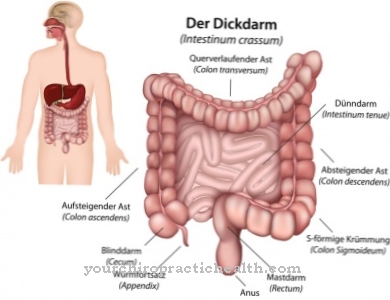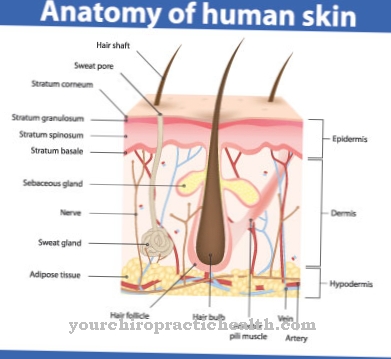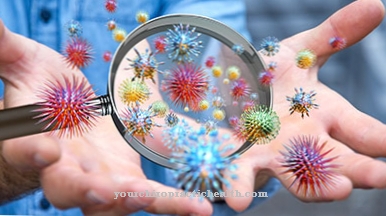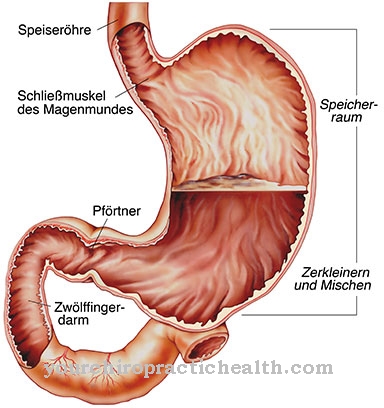Genital warts or pointed condylomas are the symptom of a disease with the human papillomavirus (HPV). Among other things, this is suspected of causing cervical cancer. Genital warts belong to the group of sexually transmitted diseases.
What are genital warts (HPV)?
.jpg)
© blueringmedia - stock.adobe.com
Genital warts are brownish-gray, small to large and flat warts in the genital and anal area.
They arise due to the genital transmission of the human papillomavirus and can therefore not only occur in the genital area, but also in other parts of the body that come into closer contact with the genitals. The incubation period ranges from a few days to several years, and genital warts usually heal completely.
In the case of severe infestation, however, they can also break open and cause bleeding. In addition, there is seldom pain, so that the genital warts can remain undetected for a long time - sometimes they do not form at all despite HPV infection.
causes
The cause of genital warts is infection with the human papillomavirus. These are suspected of causing cancers such as cervical cancer, penile cancer or cancers of the mouth and throat - genital warts, however, are triggered by a low-risk type.
They occur through contact or smear infection with the virus during sexual intercourse or other sexual activities. In order for an infection to occur, other beneficial factors must also be present.
If, for example, there are minimal injuries to the mucous membranes that can quickly occur unnoticed, the viruses nest on them. Moisture or a generally weakened immune system, for example due to a current cold, also ensure that genital warts can develop, as the HPV settles more easily.
Symptoms, ailments & signs
The majority of infections with human papilloma viruses are completely symptom-free, so that those affected do not learn anything about their disease despite an infection with the genital warts pathogen. Nevertheless, they are virus carriers and can accordingly be infectious. Sometimes developing genital warts are so small and not growing that they are not noticeable.
Genital warts that grow in places that are difficult to see (for example, intrarectal) can only be detected to a limited extent. Individual genital warts usually do not cause pain or other irritation. Occasionally, however, the growths can lead to small bleeding or give off secretions. This also depends on where they grow and to what extent the affected parts of the body are mechanically stressed.
Grown genital warts are clearly visible as darker elevations from a certain size. These can be of different colors and form in the genital, rectal or oral area. They multiply at different speeds and in some cases lead to a veritable overgrowth of the affected area.
Several small warts can combine into larger ones. Individual warts can show steady growth. Genital warts in particular can lead to tears or eczema - but this is only to be feared if the disease progresses without treatment. While around 90 percent of all infections are caused by low-risk types of HPV, which only lead to treatable genital warts, degeneration is possible with the remaining infections.
It can - also depending on the location - lead to the formation of tumors due to tissue overgrowth and damage. Untreated infections and larger collections of warts can degenerate and sometimes lead to so-called Buschke-Löwenstein tumors. These are dangerous degeneracies.
course
The course of genital warts is as follows: The infection with the human papilloma virus is followed by the incubation period.
It takes an average of a few days or weeks for the first symptoms to appear. Less often, these appear after a few days or even after several years. Initially, a few warts will form in the affected area. These tend to form beds and the genital warts spread further:
They are interconnected and cover an ever larger area of the skin. In some cases, the genital warts then heal on their own; in severe cases, they form large clusters of tumors that can bleed significantly.
Complications
Genital warts can be surgically removed by a doctor. Various methods are available for this (laser, cryotherapy and electrotherapy. Depending on the procedure, the doctor can injure blood vessels, which then leads to bleeding. Genital warts can also be treated with medication in self-therapy.
Tinctures from the active ingredient group podophyllotoxin or imiquimod are applied to the warts, which can lead to very unpleasant skin irritations. It is therefore essential to ensure that only the warts are coated and the surrounding skin is carefully covered. The drugs must not be used during pregnancy as they can cause complications during the further course of pregnancy.
The patient can use trichloroacetic acid, which can remove about 20 percent of the genital warts. In about 30 percent of all affected patients, the genital warts cannot be treated with the above remedies. In addition, not all those affected notice the infection with the HP virus, so treatment is not carried out.
In such cases the genital warts begin to proliferate and, in the worst case, lead to the development of a malignant tumor. If proliferating genital warts appear during pregnancy that are not treated or that do not respond to therapy, the birth canal may shift. A vaginal delivery is then no longer possible and the doctor will have to perform a caesarean section.
When should you go to the doctor?
If the genital warts are cosmetically disturbing, a doctor should be consulted at the first opportunity. Inflammation, bleeding and severe itching are good reasons to consult a doctor immediately. A visit to your family doctor or dermatologist is also recommended if the warts are spreading rapidly. If the pointed condylomata “sit on” other skin diseases (such as neurodermatitis), a dermatologist must be consulted.
The same applies if the growths appear in other parts of the body overnight or suddenly cause pain, itching and other symptoms. Medical clarification is also useful if there is an acute risk of infection for others. Children and people over the age of 45 are particularly susceptible to genital warts.
Like patients with neurodermatitis or a past HPV infection, they should speak to a doctor and have the skin changes clarified. The doctor can remove the growth quickly and without pain and inform the person concerned about the sexual and hygienic problems that genital warts bring with them.
Doctors & therapists in your area
Treatment & Therapy
In the foreground of the treatment of genital warts is first of all information about the type of virus that causes the genital warts. If it is a low-risk type, there is no danger - but there are also carcinogenic forms that are very dangerous, especially for women, and can cause cervical cancer. In the foreground is then the precaution for quick detection in an emergency.
However, the low risk type continues to be treated seamlessly. First of all, the genital warts can be removed surgically, for example surgically or using methods such as cautery or freezing. This is followed by drug treatment. The warts are usually rubbed with the drug so that it can work directly. First of all, cytostatics, which are also used in cancer to stop the growth of genital warts - 5-fluorouracil is considered the standard drug.
In addition, drugs such as interferon are prescribed to stimulate the local immune system and induce the body to produce immune cells that kill the genital warts from within. Above all, interferons have a tumor-inhibiting effect and offer protection against possible cancer diseases, which is why they are also used in the high-risk type of human papillomavirus.
Outlook & forecast
In spite of their high risk of infection, genital warts generally have a good prognosis. The warts caused by the papilloma virus can spread rapidly within a short time. Without medical care, there is a risk of a steady increase in benign skin changes. They can also lead to complications of the menstrual cycle or within an existing pregnancy. In addition, there is a high probability that future sexual partners will be infected with the virus as well as the warts.
The particular difficulty lies in determining the genital warts. Often the skin changes go undetected because they do not trigger any further symptoms in many of those affected and settle in areas of the body that are difficult to access and difficult to see. After a diagnosis and medical treatment, the patient is free of symptoms in most cases.
The warts are completely removed in a medical procedure. This is followed by drug treatment to kill the papillomavirus. The affected person can be discharged from treatment within a few weeks.
Despite the good prospect of healing, the warts can develop again at any time. In very rare cases genital warts mutate into malignant tumors. The otherwise favorable prognosis worsens in these patients and is linked to the stage of the disease at the start of treatment.There is a risk of fatal disease.
prevention
The best way to prevent genital warts is through safe contraception and caution when choosing a sexual partner. Contraception has to be understood from methods like the condom or femidom if you don't know each other or if you don't live monogamous, as only they can prevent direct contact between the two people.
In order to prevent genital warts, one should inform oneself beforehand about the sexual behavior and possible infections of the partner. People who have not had sexual intercourse can get a preventive vaccination against HPV.
However, the vaccine is still new and no reliable statements can be made about the duration of its effect. In addition, there have been unclear, sudden deaths in young women after vaccination, which, however, have not yet been clearly linked to the vaccine.
Aftercare
Follow-up care for genital warts consists of check-ups that follow previous operations. The follow-up examinations are necessary closely after treatment of the warts. The reason for this is that the different strains of the virus (and accordingly the warts) can recur.
These are not necessarily where genital warts have been seen and treated. In addition, warts in the rectum or within the vagina are also possible, which can cause them to spread again. An HPV infection is therefore only treated as if no further warts have been found for many months.
During the follow-up visits, the doctor in charge will therefore carefully examine susceptible areas in order to detect even the smallest warts and prevent them from spreading again through treatment. If creams or suppositories are used for treatment, no further action is required after completing this treatment. This is different if the genital warts have been surgically removed.
Wound treatment is sometimes necessary for weeks. Since the relevant areas are often the genital region, hygiene is particularly important. In addition, the wounds should not be touched and kept dry. If necessary, covers and bandages are available. In addition, the life partner should be urgently examined and, if necessary, treated to rule out a new infection with HPV.
You can do that yourself
In addition to medical treatment, the patient can also fight the genital warts with various home and alternative remedies. However, their effectiveness is often different.
One of the most effective home remedies for genital warts is tea tree oil. It has proven itself well in fighting those pesky warts. However, it is important to always use tea tree oil, which is skin-friendly. It can be bought in the pharmacy. The tea tree oil reactivates the affected immune system, which in turn causes the germs responsible to die off.
Most users tolerate tea tree oil well because it consists exclusively of natural substances. At the beginning of the treatment, however, it is advisable to use the tea tree oil cautiously, so that the symptoms do not worsen in the event of negative reactions.
Another proven natural remedy for skin diseases such as genital warts is aloe vera. It is offered both in the form of a gel and in liquid form. As an alternative, the fresh juice from an aloe vera plant can also be used. The natural remedy is administered in the morning and in the evening before going to bed. The patient rubs the aloe vera on the affected areas.
Hemorrhoidal ointment is also suitable for treating genital warts. It actually serves to fight hemorrhoids, but its ingredients also act against swelling and itching in the genital region. The application takes place two to four times a day.













.jpg)

.jpg)
.jpg)











.jpg)